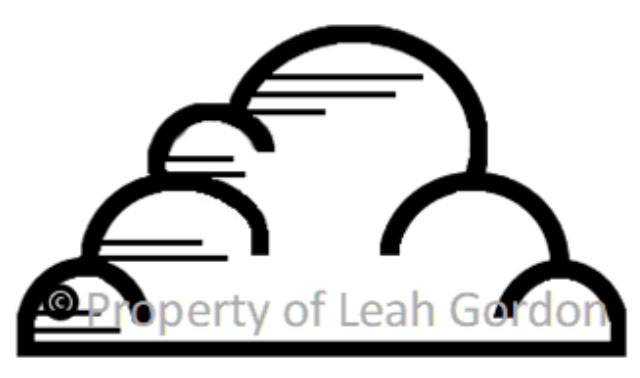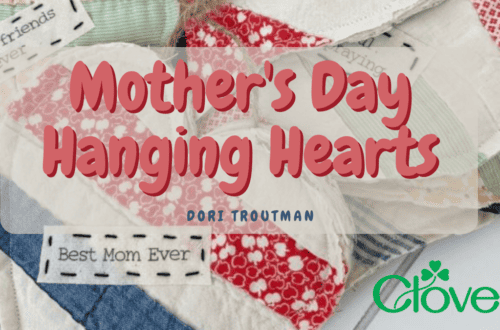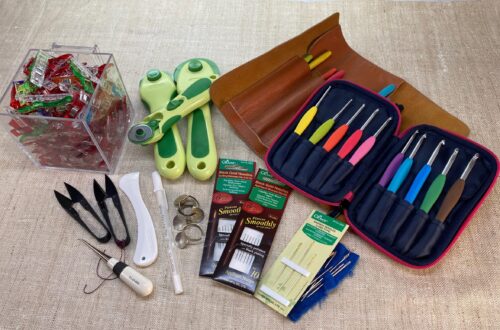Embroidery Stitching Tool Review
The Embroidery Stitching Tool is a unique approach to the art of embroidery. For crafters and artists familiar with punch needing (needle punching/rug hooking), this style of embroidery will feel quite familiar.
Disclosure: This post contains affiliate links, which means I (Leah Gordon) may earn a small commission from purchases made, at no additional cost to you. These are products I highly recommend and use.

Q: What makes this tool different from other needles?
A: This tool consists of a hollow needle with a hole at the tip of the needle. These two holes make it possible for the needle to be threaded; while allowing the working fibers to be housed and punched directly into a foundation or backing cloth. There are 4 separate needles (refills) designed for the tool. Each needle is capable of housing a different ply of thread up to medium yarn and embroidery ribbon. One super helpful characteristic of the stitching tool is the adjustable holder. The holder allows for the refills to be quickly swapped out, and for the needle’s height to be raised or lowered. Adjusting the height of the needle alters the height of the loops, creating a multitude of depths and textural possibilities.

If you are wondering how all this works, allow me to explain. It is magic, yes, MAGIC! Of course, I am joking.
Q: How does the working fiber stay in the fabric?
A: The weave of the foundation or backing cloth is doing almost all the work. As the Embroidery Stitching Tool punches the fiber into the cloth, the punched fibers are filling in the gaps naturally created by the weave of the fabric. A dense fabric with an even weave such as canvas, broadcloth, or poplin etc. would work great as a foundation or backing cloth. You will want to steer clear of stretchy or coarse fabrics, as they could very easily tear while being punched with the working fiber.
Q: Are mistakes permanent?
A: This is a forgiving craft! You can easily rip out your work as if you were frogging a crochet or knit project, reposition the needle, and continue punching. Another available option would be to use a seam ripper. I would recommend frogging (pulling the threads back) to save your working fiber’s integrity versus slicing your thread or yarn with a seam ripper. The use of a seam ripper should be a last resort tactic in undoing work. We have now reached the end of the magic and the beginning of practicality.
Q: Can the Embroidery Stitching Tool make any stitch?
A: No. This tool does have its own set of limitations. You will only be able to effectively create loops (think rug pile), back stitch, and satin stitch. You can increase textural possibilities by cutting loops in your design to add a shaggy or velvet like appearance to your work. Swapping out the various refills can make it easier to outline, fill in, and target large scale areas or fine details. Next up, let’s work up a beginner friendly project to get familiar with back and satin stitches.

Wee Lil Cloud Embroidery Pattern
by Leah Gordon
Craft: Punch Needle Embroidery
Skill Level: Easy
Time: 30 minute – 1 hour
Stitches: Back Stitch & Satin Stitch
Materials
- Embroidery Stitching Tool (Art. No 8800)
- or Gold Eye Embroidery Needle – Size 7 (Art. No 235)
- Embroidery Hoop 4 3/4″ (Art. No 8813)
- Mini Patchwork Scissors (Art. No 493/CW)
- Chacopen Blue with Eraser (Art. No 5013)
- Tapestry Needle Set (Art. No 339)
- DMC Threads #3755, DMC #826, and DMC #828 (or colors of choice)
- Duck canvas or foundation cloth of choice
- Felt
- 4” Wooden Hoop (optional for mounting finished project)
- Sticky Fabric-Solvy
Notes
- Back Stitch – begin by punching the needle down into the fabric. Be sure the holder contacts the foundation cloth. Carefully draw the needle back up onto the top of your cloth. Without picking up the needle off the cloth, drag the needle forward, and punch down into the cloth to complete the stitch. Repeat previous steps until desired amount of stitches are created.
- Satin Stitch – begin by punching the needle down into the fabric. Be sure the holder contacts the foundation cloth. Carefully draw the needle back up onto the top of your cloth. Without picking up the needle off the cloth, drag the needle diagonally, and punch down into the cloth to complete the stitch. Repeat previous steps making tight back forth (side to side) zig zag motions.
The Embroidery Stitching Tool provides complete instructions and visual aids for these stitches. Disregard separate 4” hoop and any related instructions if your project is will be applied to clothing; or used any other way except as the described wall décor.
Template
If you would like to support my work, purchase the inexpensive complete watermark-free ad-free printable templates and pattern download here.

Pattern
Step 1: Prepare your hoop. Place foundation cloth on top of inner hoop. Be sure edge of inner hoop is facing up.
Step 2: Using a water-soluble pen, sketch cloud onto your foundation cloth. If you are using suggested stabilizer, print template design directly onto stabilizer (use as directed). Another option to consider, sketch template design onto stabilizer if you don’t feel comfortable sketching directly onto your cloth, or printing onto stabilizer.

Step 3: Using scissors cut a 15” strand of DMC #3755 6 ply thread. Divide thread to only work with 3 ply at a time. Thread your needle with 3 strands of DMC #3755.
Step 4: Using satin stitches begin punching outline of cloud. Repeat Step 3 as necessary until outline is complete.
Step 5: Repeat Step 3 for colors DMC #826 & DMC #828.
Next, go over strike details with back stitches using 3 strands of DMC #826 and DMC #828. It’s completely up to you to decide which strikes to make which color. I alternated each strike from dark to light, bottom up.
Finish
- Trim ends to clean up work.
- Using the 4’’ hoop as a template trace a 4’’ circle on the felt, cut out circle, and set aside.
- If stabilizer was used, trim excess and dissolve remnants (per label instructions). Let dry.
- Remove the project from your working 4 ¾’’ working hoop, transfer work to the 4″ hoop. This hoop will serve as a frame to hang your artwork.
- Trim excess foundation cloth, leaving about a ½’’ in length around frame.
- Thread your tapestry needle and make a running stitch around remaining excess foundation cloth. Using ends of the running stitch, pull and cinch excess cloth towards the center of the back side of your project. Secure ends with a knot.
- Glue felt circle on top of running stitches to conceal back side of the frame.
- Once glue is dry, hang your project and ENJOY!

This pattern and its contents are sole property of Leah Gordon. You may not sell or redistribute any portion or use these images as your own. You can sell small batch replicas of items made using this pattern. Link back to my shop or Instagram to properly credit me for the pattern.
Final Thoughts
I think this tool is a FUN and FAST way to approach embroidery and punch needle. This style of embroidery requires little thread or fibers which is another plus. The main downside is the limitation of stitches this tool can create. As with any craft, punch needle embroidery requires practice. With enough practice, it would be nearly impossible to differentiate between embroidery created with the Embroidery Stitching Tool, or a typical embroidery needle. I’m grateful for the opportunity to try out this tool and each refill. I have found another winner to add to my collection of Clover products.
DO give this tool a try. Let your imagination stitch wild! Use hashtag #IPlayWithFiber to share WIPs and finished projects with me on Instagram, @IPlayWithFiber. I look forward to connecting with you!
Find the I Play With Fiber on Instagram | Pinterest | Youtube | Ravelry | Email
Stay connected with Clover on Facebook | Twitter | Instagram | Pinterest | YouTube | Ravelry
[mc4wp_form id=”11289″]


